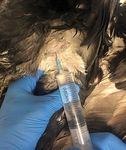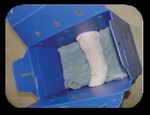Native Birds Veterinary Triage & Assessment - Wildlife Heroes
←
→
Page content transcription
If your browser does not render page correctly, please read the page content below
Triage & Assessment of
NATIVE BIRDS
Be aware Feeding
• Be careful of beak, claws, wings and a combination • A water dish and appropriate food should
of these. always be provided, but many birds will not
• Wire cages can severely damage feathers. Avoid eat in hospital. Birds should be transferred to
using unless you are able to line with cardboard an experienced wildlife rehabilitator as soon
as veterinary treatment is no longer required.
Handling or shade cloth. A cardboard box or pet carrier is
more suitable in the short term. Prioritise fluid therapy, warmth and first aid over
• A towel can be used to contain wings and feet, feeding for the first 1- 2 days.
• When restraining birds, avoid restricting sternal
protect feathers and redirect bites. • The following foods can be offered as an interim
movement as birds do not have a diaphragm j
• Small birds - gently cradle in your hand, and rely solely on the movement of their ribcage while expert advice and care is sought:
using a ‘V’ grip (a) for inspiration.
• Medium sized birds - hold your hand around • Always be aware of
Type Example Food
Anaesthesia
Carnivores Magpies Crushed dog kibble or canned
the wings, with the feet secured between your zoonotic disease and dog food • Due to the difficulty with intubation of small birds,
fingers (b) wear appropriate PPE mask induction is preferred.
Herbivores Ducks Chopped greens
• Parrots - grasp behind the head, with thumb when handling wild birds. • Create a firm fitting mask for patients using co flex
Granivores Most parrots Budgie mix or sunflower seed
and fingers on either side of the jaw to firmly according to size bandage or a latex glove, leaving a small hole for
control the jaw (c) an ideal fit and to minimize anaesthetic leaks (j).
Nectarivores Lorikeets and Commercial nectarivore mix in
• Birds of prey - have talons and a sharp beak; honeyeaters a feeder • Water bird and pigeon like species
restrain both limbs at the hocks to avoid injury Housing Insectivores Willy wagtail A mix of commercial insectivore (columbiformes) can breath-hold and can be slow
to the bird and yourself. Always keep control • The best temporary set mix and mealworms to induce. Prior sedation may help.
of the talons and position them away from up is a box with air holes g
• Intubate the bird where possible.
yourself and others (d) away from their eye line. • Crop feeding is an expert technique and
Waxed cardboard pet packs are ideal and easy to should only ever be attempted by experienced • During anaesthesia, use a bair hugger®, heat lamp
• Larger birds - gently secure the head with one
clean (although not for parrots who can chew their practitioners. or heat mat to maintain the patient’s core body
hand and hold the body in the other, ensure the
way out). Do not add biological material like straw temperature. Vetario® or Humidicribs are ideal for
wings are contained (e,f)
or leaves. A towel can be used to line the bottom. post-operative recovery.
• A rolled-up towel will provide a perch and keep
the bird elevated, protecting its tail feathers (g).
• Young or debilitated birds unable to perch need
to be supported – use a rolled-up doughnut
Euthanasia
shaped towel (i). Fauna should be euthanised immediately when:
• Provide warmth using an external heat source • Death is imminent or highly likely, regardless of
(heat pack, lamp) or by placing the bird in a the treatment provided.
humidicrib. Ensure heat source is not in direct • It is suffering from chronic, un-relievable pain or
contact with the bird. distress.
i
a b • It is carrying or is suspected to be carrying an
incurable disease that may pose a health risk to
wild animals (e.g. Psittacine beak and feather
Fluid therapy Examination disease).
• SC fluids can be given in the inguinal region of • Its ability to consume food unaided is permanently
• Birds may appear alert despite being sick or
the thigh (h). Remember that there are air sacs impaired (e.g. missing or injured beak, loss
injured. Be sure to observe behaviour from afar
in the caudal coelomic cavity. Keep the needle of vision).
if no abnormalities are obvious
superficial.
• Check wings and legs for injuries, fractures Mask induction and anaesthesia is recommended
• Warm fluids prior to euthanasia. Once anaesthetised euthanasia
and asymmetry. i.e. a dropped wing.
c d beforehand and is performed by IV injection of pentobarbitone.
give up to 10% of • Feel for body condition – a prominent keel Suitable IV sites include the jugular vein, basilic vein
body weight SC indicates poor condition and likely chronic disease. or medial metatarsal vein. Pentobarbitone should
or very slow IV. • Check for feather loss or pinched quills. Note NOT be injected intracoelomically in birds.
• Suitable fluids all birds (apart from waterbirds) have natural
include: 0.45% featherless tracts (apteria).
NaCl and 2.5% • Check mouth, nostrils and eyes for blood,
glucose, 0.9%
NaCl, and
discharge and parasites. Scan QR code for
e f Hartmann’s • Once stable, perform a flight test in a confined more resources
h room if possible.
Solution.The information supplied in
this booklet is intended to
assist veterinary practitioners in
providing initial care and first aid
to wild birds. The information
provided has been sourced
from and reviewed by qualified
veterinarians. Birds requiring
ongoing hospitalisation will
require input from experienced
rehabilitators to address
husbandry and housing needs.
Birds no longer requiring
veterinary care should be
transferred to an appropriate
rehabilitator as soon as possible.
Supported by:
The Wildlife Heroes National Program
is supported by the Australian
Government’s Wildlife Rescue and
Rehabilitation Initiative.
Photo on cover: K. GriffithsYou can also read
























































